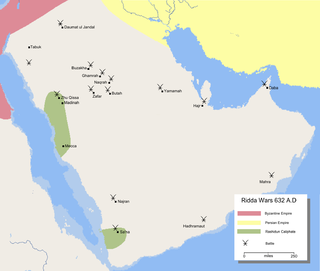Related Research Articles

Umar ibn al-Khattab, also spelled Omar, was the second Rashidun caliph, ruling from August 634, when he succeeded Abu Bakr as the second caliph, until his assassination in 644. Umar was a senior companion and father-in-law of the Islamic prophet Muhammad.

Najd is the central region of Saudi Arabia, in which about a third of the country's modern population resides. It is the home of the House of Saud, from which it pursued unification with Hejaz since the time of the Emirate of Diriyah.
Islam is the state religion in Oman, introduced during the Prophet Muhammad's lifetime in the early 7th century. Muhammad appointed Amr ibn al-As as governor, who remained until Muhammad's death in 632 CE. Amr and Sa'id ibn Aws al-Ansari delivered Muhammad's letter to the Al-Julanda brothers; the rulers of Oman, inviting them to embrace Islam. This peaceful mission marked the beginning of Islam in Oman. Today, 85.9% of Oman's population is Muslim, with 53.4% following Sunni Islam, 39.8% Ibadi Islam, and 5.8% identifying as Shia Muslims.
This is an alphabetical list of topics related to Islam, the history of Islam, Islamic culture, and the present-day Muslim world, intended to provide inspiration for the creation of new articles and categories. This list is not complete; please add to it as needed. This list may contain multiple transliterations of the same word: please do not delete the multiple alternative spellings—instead, please make redirects to the appropriate pre-existing Wikipedia article if one is present.

The Azd, or Al-Azd, is an ancient Arabian tribe. The lands of Azd occupied an area west of Bisha and Al Bahah in what is today Saudi Arabia.
Banū Tamīm is an Arab tribe that originated in Najd in the Arabian Peninsula. It is mainly present in Saudi Arabia, Qatar, Kuwait, Iraq, Jordan and Lebanon, a strong presence in Algeria, and Morocco, Palestine, Tunisia, and Libya. It is also present in many other parts of the Arab world such as Egypt and Khuzestan in Iran. The word Tamim in Arabic means strong and solid. It can also mean those who strive for perfection.

The Ridda Wars were a series of military campaigns launched by the first caliph Abu Bakr against rebellious Arabian tribes. They began shortly after the death of the Islamic prophet Muhammad in 632 and concluded the next year, with all battles won by the Rashidun Caliphate.

The Banu Abs are an ancient Bedouin tribe that originated in central Arabia. They form a branch of the powerful and numerous Ghatafan tribes. They still inhabit the Arabian Peninsula and North Africa but have spread to many other regions of the world, as well. Their descendants today include the large Al Qubaisat tribe located in United Arab Emirates, Bani Rasheed tribe located in Saudi Arabia, Qatar, Yemen, Kuwait, United Arab Emirates, Oman, Sudan, Eritrea, and Jordan, and the Banu Rawaha located mostly in Oman and the UAE. They are known to be the second strongest tribe after The Prophet's Tribe. Parts of the Mahas tribe of the Butana region in Sudan are also linked by blood to the Banu Abs due to intermarriage between the Sudanese Rashaida tribe and the Mahas peoples. One of the earliest stories concerning this tribe was the famous classical love and war story of Antar and Abla.
There were several Arabian tribes that interacted with Muhammad.

The Banu al-Harith is an Arabian tribe which once governed the cities of Najran, Taif, and Bisha, now located in southern Saudi Arabia.
The Banu Sulaym is an Arab tribe that dominated part of the Hejaz in the pre-Islamic era. They maintained close ties with the Quraysh of Mecca and the inhabitants of Medina, and fought in a number of battles against the Islamic prophet Muhammad before ultimately converting to Islam before his death in 632. They took part in the Muslim conquest of Syria, and established themselves in the Jazira, while part of the tribe remained in the Hejaz. During the early Muslim period, the tribe produced notable generals such as Safwan ibn Mu'attal, Abu'l-A'war and Umayr ibn al-Hubab. Those who remained in Arabia were largely absorbed by the Banu Harb of Yemen beginning in the 9th century, while those in Syria and the Jazira were expelled to Upper Egypt by the Fatimid Caliphs in the late 10th century for supporting the Qarmatians. In the mid-11th century, a prolonged famine in Egypt prompted the tribe to migrate westward with the Banu Hilal into Libya. There, the Sulaym and its sub-tribes established themselves mainly in Cyrenaica, where to the present day, many of the Arab tribes of that region trace their descent to the Sulaym.

Zahran, also known as Banū ʿZahrān ibn Kaʿab, is one of the oldest Arabian tribes in the Arabian Peninsula. It is regarded as one of the largest tribes in Al Bahah Province, also known as 'the Garden of Hejaz' and 'the region of 1001 towers' due to its natural beauty and numerous traditional stone towers dotted throughout the region.
It is believed that Jews began immigrating to the Arabian Peninsula in as early as the 6th century BCE, when the Babylonian conquest of Judah triggered a mass Jewish exodus from Judea in the Land of Israel. Over time and through successive exiles, the local Jewish tribes, who were concentrated in the Hejaz and partly in South Arabia, established themselves as one of the most prominent ethno-religious communities of pre-Islamic Arabia. Likewise, Judaism, which had been introduced as one of the few monotheistic religions in the region, stood as a deviation from the typical polytheistic practices of Arabian paganism. These Jewish tribes continued to have a presence in Arabia during the rise of Muhammad, who founded Islam in the 7th century CE. Muhammad's interaction with the Jewish community is documented to a considerable degree in Islamic literature, including in many ahadith. The Jewish tribes of the Hejaz are seen in Islam as having been the offspring of the Israelites/Hebrews Two of Muhammad's wives were Jewish: Safiyya bint Huyayy and Rayhanah bint Zayd, both of whom belonged to the Banu Nadir by birth, though Rayhanah's status as a wife is disputed.
Banu Hanifa is an ancient Arab tribe inhabiting the area of al-Yamama in the central region of modern-day Saudi Arabia. The tribe belongs to the great Rabi'ah branch of North Arabian tribes, which also included Abdul Qays, Taghlib, al-Nammir ibn Qasit, and Anazzah. Though counted by the classical Arab genealogists as a Christian branch of Bani Bakr, they led an independent existence prior to Islam. The ruling House of Saud of Saudi Arabia belongs to it.
The Banu Amir was a large and ancient Arab tribe originating from Western Arabia that dominated Najd for centuries after the rise of Islam. It is an Arab Adnanite tribe whose lineage traces back to Adnan and Ishmael, son of Abraham through Hawazin, and its original homeland was the border area between Nejd and Hejaz in Khurmah and Ranyah. Although the Banu Amir engaged in a long war with the Quraysh before the appearance of Islam —manifesting in particular as the Fijar War — the tribe gave a late allegiance to Muhammad and his immediate successors. The tribe produced several well-known Arabic poets, the most famous of whom was Labid ibn Rabi'ah, an author of one of the Seven Hanged Poems. Other poets included Amir ibn al-Tufayl, an important tribal chief; al-Ra'i al-Numayri, an opponent of Jarir; and the female poet Layla al-Akhyaliyyah. The protagonists of the romantic saga of Layla wal Majnun, Qays and Layla, also belonged to Banu Amir.
Rabīʿa ibn Nizar is the patriarch of one of two main branches of the "North Arabian" (Adnanite) tribes, the other branch being founded by Mudhar.
Banu Uqayl are an ancient Arab tribe that played an important role in the history of Eastern Arabia and Iraq. They belonged to the Banu Ka'b branch of the large Banu 'Amir confederation.
The Ghamd is an Azd Arab tribe of the Hejaz Region. They are predominantly Sunni, and are considered one of the oldest tribes of the Arabian Peninsula. The Ghamid people are thought to be closely related to the neighboring tribe of Zahran.

The Nabhani dynasty, members of the Bani Nabhan family, also referred to as the Sultans of Sohar, were rulers of Oman from 1154 until 1624, when the Yaruba dynasty took power. One of their most visible legacies is the Bahla Fort, a large complex of mud brick buildings on stone foundations built from the 12th to the 15th century. It was registered in 1987 as a UNESCO World Heritage Site.
Balī is an Arab tribe present in northwestern Saudi Arabia, Jordan and historically in Egypt and Sudan and a major component of the Quda'a tribal grouping. In the pre-Islamic period, the southern branches of the tribe inhabited northwestern Arabia and developed close ties with Jewish communities resident in its oases, while the northern branch established itself in Transjordan and served as auxiliaries of the Byzantine Empire. With the advent of Islam, Bali townspeople in Medina embraced the new religion and several were slain fighting the Quraysh of Mecca.
References
- 1 2 Pinaki (2017-10-22). "The Aufis of Wadi Bani Auf". Pinaki / Photographic Literature. Retrieved 2024-05-22.
- ↑ "Wadi Bani Awf | Oman, Middle East | Attractions". Lonely Planet. Retrieved 2024-05-22.
- 1 2 3 "The Story of Abdur-Rahman Ibn Awf". www.islamreligion.com. Retrieved 2024-05-22.
- 1 2 Rabba Dr Lindsey Taylor-Guthartz. "Torah in Motion" (PDF). Torah in Motion.
- ↑ "Focus on the Early History of Islam: A Refreshing Look at the Seerah (Part 3)". IslamOnline. 2023-02-01. Retrieved 2024-05-22.
- ↑ "THE ISLAM IN OMAN | Silk Roads Programme". en.unesco.org. Retrieved 2024-05-22.
- 1 2 3 4 5 Carter, JRL (1982). Tribes in Oman. Peninsular Pub. ISBN 978-0907151029.
- ↑ "ʿAdnān | Arabian legendary figure | Britannica". www.britannica.com. Retrieved 2024-05-22.
- ↑ Miles, SB (1919). The Countries and Tribes of The Persian Gulf.
- 1 2 Ibn Razik, Salil. The History of the Imams and Seyyids of Oman.
- ↑ Mendoza, Jomar (2024-02-24). "Al Aufi unveils bold vision for energy transition in Oman". Oman Observer. Retrieved 2024-05-23.
- ↑ "About Us". Ali Al Aufy Trad Co. Retrieved 2024-05-23.
- ↑ Zacharias, Anna (2020-02-25). "Omani mother who brought literacy to remote mountain villages wins Ruler of Dubai award". The National. Retrieved 2024-05-23.